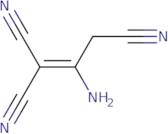2-Aminoprop-1-ene-1,1,3-tricarbonitrile
CAS: 868-54-2
Ref. 3D-FA178226
| 5g | Descatalogado | ||
| 10g | Descatalogado | ||
| 25g | Descatalogado |
Información del producto
- (1-Amino-2-cyanoethylidene)malononitrile
- 1,1,3-Tricyano-2-amino-1-propene
- 1,1,3-Tricyano-2-aminopropene
- 1-Propene-1,1,3-tricarbonitrile, 2-amino-
- 2-Amino-1,1,3-propenetricarbonitrile
- 2-Amino-1,1,3-tricyano-1-propene
- 2-Amino-1,1,3-tricyanopropene
- 2-Aminoprop-1-Ene-1,1,3-Tricarbonitrile
- Malononitrile, dimer
- NSC 77901
- Ver más sinónimos
- Triap
- U 9189
- Upjohn 9189
2-Aminoprop-1-ene-1,1,3-tricarbonitrile (APET) has been found to be cytotoxic in the cell nucleus. It is an organic compound that can be used in the treatment of congestive heart failure and other cardiovascular diseases. APET has also been shown to have a metabolic rate and water vapor absorption similar to those of malonic acid, which may account for its biological properties. The reaction mechanism of APET is not yet known but it is hypothesized that it may involve diazonium salt or hydrochloric acid. APET has been classified as a risk group 2B carcinogen by the International Agency for Research on Cancer (IARC).





